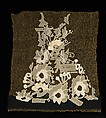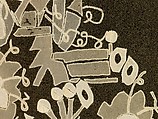Habit à la disposition
Designer Sarah Lipska Polish
Not on view
This object is from a collection of sample embroideries, which was originally owned by Morris de Camp Crawford, editor of Women's Wear Daily, who collected objects which told the story of fashion and fabric history. Included in this collection was a group of textiles which illustrated what American and French designers and manufacturers were using. According to Crawford's book The Ways of Fashion, the work of Polish artist Sarah Lipska (1882-1973) was represented in this collection. Lipska is an enigmatic figure, who is known to have worked with Leon Bakst as a set and costume designer for the Ballets Russes, and later in the 1920s as a fashion designer in Paris at 4 rue Belloni, and finally as a sculptor. Extant examples of her work are rare. Although only a few pieces in the Brooklyn Museum collection bear a label or a signature, others bear hallmarks of her work, such as a distinctive form of whip stitching on appliqué work, unusual abstract motifs, and Cubist-inspired patterns.
This embroidery illustrates Lipska's penchant for using geometric, abstract, Cubist-inspired motifs. As many Cubist artists did, she takes a form such as the flower and deconstructs it, making the leaves and stem geometric and graphic, and leaving the flower itself in a soft, feminine state. The subtle and thoughtful use of velvet, crepe and chiffon for the appliqués over the lustrous gold metallic net ground adds texture and visual interest to the design. As in 2009.300.3555, Lipska uses wool thread for her signature whip stitch outlining of the appliqués. The end result would make a very distinctive, eye-catching garment.
Due to rights restrictions, this image cannot be enlarged, viewed at full screen, or downloaded.
This artwork is meant to be viewed from right to left. Scroll left to view more.



